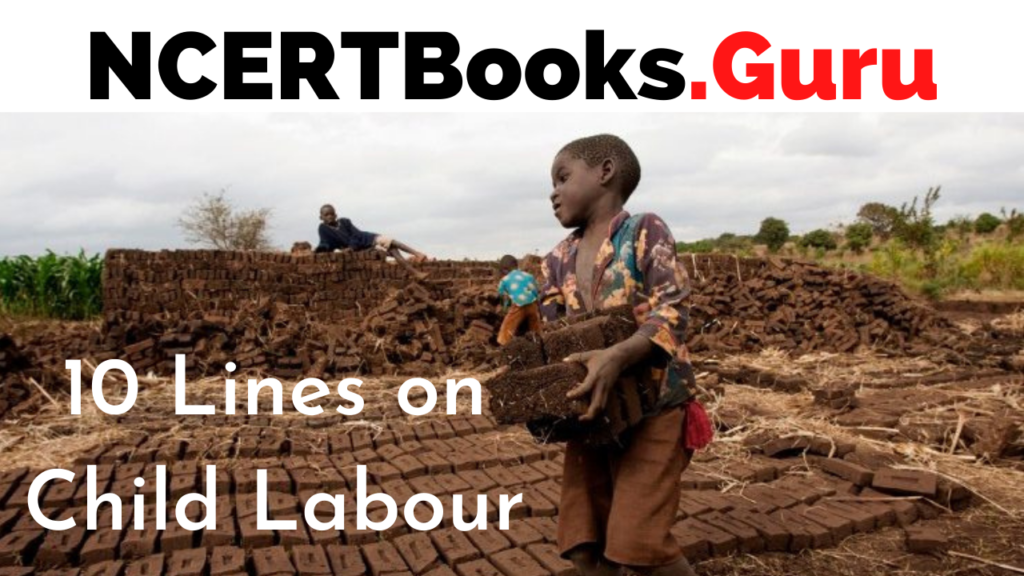10 Lines on Child Labour: Child labour is the exploitation of children through any form of work that deprives children of their childhood, intervenes with their ability to attend regular school, and is mentally, physically, socially, or morally harmful.
Such exploitations are prohibited by legislations worldwide. Although these laws do not count all work by children as child labour, exceptions include work by child artists, family duties, and some other practices.
Child labour practice has existed to varying extents throughout history. In the nineteenth century, many children aged five to fourteen, from low-income families worked in western nations and their colonies. Globally the incidence of child labour has decreased. However, the total number of child labourers remain high.
Enhance your vocabulary and writing skills with 10 Lines Essays available. Spark up the creativity in you and access various Topics on 10 Lines all in one place.
Set 1 – 10 Lines on Child Labour for kids
Set 1 is helpful for students of Classes 1, 2, 3, 4 and 5.
- Child labour refers to any act which deprives children of their childhood.
- Child labour is an invasion of basic human rights.
- Child labour is expanding day by day, and the childhoods of children are getting worse.
- Many children are forced to labour and are separated from their parents.
- A large number of under-aged children work in brick kilns.
- In most countries, the age limit for employment is 14 years, and anything below is illegal.
- Parents tend to send their children to earn money instead of getting them educated because of poverty and hunger.
- Lack of necessary facilities, overpopulation and corruption, all leads to child labour in a country.
- Young children are also employed in the service sector industry, such as restaurants and real estates.
- Factories practice child labour because it is cheaper than employing adult labourers.
Set 2 – 10 Lines on Child Labour for School Children
Set 2 is helpful for students of Classes 6, 7 and 8.
- According to the United Nations, child labour is the highest in African nations compared to the rest of the world.
- All nations are taking adequate measures to stop child labour.
- Children falling below the age of fourteen are not allowed to indulge in any work forcefully.
- More than one fifty million under-aged children in the world indulge in child labour.
- Lack of proper awareness in remote areas is a problem which ultimately leads to child labour.
- Child labour act of 1986 prohibits the employment of children in any form.
- In poor countries like Sudan and the Republic of Congo, more than a quarter of the children in the country’s population are hired as child labourers.
- Poverty, ignorance, lack of family planning, and lack of basic government facilities are the leading causes of child labour.
- Child labour has been made into a business by corrupt people.
- Child labour worsens the future of the child and hinders the development of the country.
Set 3 – 10 Lines on Child Labour for Higher Class Students
Set 3 is helpful for students of Classes 9, 10, 11, 12 and Competitive Exams.
- In the face of poverty, helplessness and hunger, children fall into the quagmire of child labour.
- More than half of the child labourers are subjected to physical torture due to child labour, sexual violence and malnutrition.
- Kailash Satyarthi is a Nobel Prize-winning activist who fought against child labour and universal primary education for children.
- In rural areas, the money earned by children acts as additional income to the family.
- Primary and secondary education in many countries is free of cost and is an initiative against child labour.
- Electronic chip businesses, fast fashion retail and many other industries directly or indirectly support child labour in third world countries.
- Every year thousands of children die in query is due to mishaps, and the debts are usually never reported.
- Child labourers are employed on a mass scale in African countries for mining diamonds.
- Eliminating poverty, malnutrition, and illiteracy are the first steps that should be taken to abolish child labour.
- 12th June is marked as World day against child labour by the United Nations, to highlight child labourers’ plight.
Frequently Asked Questions on Child Labour
Question 1.
Where is child labour most common?
Answer:
A recent survey that ranks one ninety countries identifies the democratic Republic of Congo, Myanmar, Sudan, Afghanistan, Pakistan, Zimbabwe and Yemen as the top places where child labour is most prevalent.
Question 2.
Why is it essential to stop child labour?
Answer:
Child labour leads to lower wages and higher unemployment among adults. Children who work and do not go to school will end up in low paid jobs later, and so will their children, and this vicious cycle of poverty will continue.
Question 3.
Who is affected by child labour?
Answer:
Over one fifty-two million children worldwide are victims of child labour. Girls leave school early to do so so disproportionately to undertake responsibility for chores within their own home. At the same time, boys are more likely to lead school premature early to join the labour force. In both ways, education is hindered.
Question 4.
What are the reasons for child labour across the world?
Answer:
Poverty, debts and corruption in local politics are some of the reasons for child labour worldwide.
